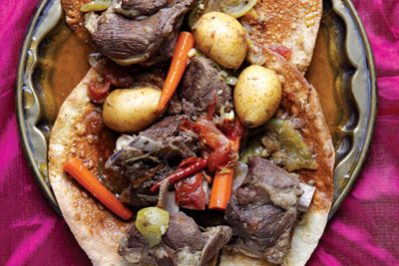[dropcap]A[/dropcap]isha (may Allaah be pleased with her) said that whenever one of her relatives died, the women assembled and then dispersed to their respective homes except her relatives and close friends. As soon as she heard of one’s passing, she (may Allah be pleased with her) would order a pot of Talbina as well as Tharid (a dish prepared from meat and bread) in which the Talbina would be poured on. Aisha (may Allah be pleased with her) would tell the women, “Eat of it, for I heard the Messenger (peace be upon him) saying, ‘The Talbina soothes the heart of the patient and relieves him from some of his sadness.’ ” [Saheeh al-Bukhaaree (5690)].
For this blessed month of Ramadhan I am going to tell you about a dish that was common in the our beloved prophet’s household called Tharid. It is a meat dish that Talbina is poured on (for the Talbina recipe, see my previous article ). Throughout history, this dish has been made with various complexities-some being simple, while some very complex. Today I will share with you a variation of medium difficulty that I created for the purpose of this article. Usually this dish is cooked with lamb, but beef can serve as a good substitute. The meat is cooked with onions and chickpeas (garbanzo beans) with various spices and boiled into a stew. It is then served over leftover bread that is a little stale and needs to be used. You’ll be surprised at how savory the meat becomes by just adding a few key spices, and how a simple warm broth softens, flavors, and brings the bread to life!
With the meal’s simplistic nature and resourcefulness, we can see our beloved prophet Mohamed’s (peace and blessings be upon him) Sunnah in action. It’s a wonderful reminder for us during Ramadhan which is a time for fasting, reflection, and self-restraint, but often turns into an eating contest once the adhan of Maghrib is called. Our beloved prophet (peace be upon him) warns us against overeating when he says, “The worst container to be filled to its utmost capacity is the stomach. It is enough for people to eat what will suffice to keep them standing, but if that is not attainable, then one third for food, one third for drink, and one third empty for air” (Tirmidhi). The preparation for this meal serves as an example of the beauty and wisdom held in the Sunnah of the prophet (peace and blessings be upon him) who did all things in the best of ways and in proper moderation.
Ingredients for Tharid: Meat and Bread Stew (serves 4)
1 pound fatty lamb (or beef), cut into pieces
1 15-oz can chickpeas, drained (if you use dried chickpeas be sure to soak them in water over night)
1 large yellow onion, peeled and chopped
Cooking oil
Water to cover the meat
Salt and pepper to taste
Ground coriander
8 slices of stale (hard – not moldy!) bread
Butter for bread (I recommend ghee/semne/clarified butter)
1. In a large pan, heat enough oil to cover the bottom of the pan and add chopped onions. Cook on medium until the onions turn translucent. Be sure to stir so they don’t burn.
2. In a large pot, brown the meat with oil the same way and add salt to taste.
3. Add the onions into the pot with the meat and cook together for a few minutes.
4. Add rinsed or soaked chickpeas to the pot and cover with water. Add pepper and ground coriander if desired (it gives more flavor to the broth).
5. Cook on medium until you see the foam of the broth surface. Remove the foam with a spoon.
6. Reduce heat and cook on low for 1 ½ – 2 hours, or until the meat is soft and tender.
7. Lay bread (buttered to your liking) onto your serving bowl and pour some broth onto it. This will soften the bread and make it flavorful. Add the rest of the stew.
8. Allow to sit and cool to edible temperature naturally, do not blow etc..
9. You may pour Talbina over the meat if desired, and serve!
Invite your neighbors and loved ones over for this hardy-meal and enjoy!
Featured photo: “Lamb Tharid,” © 2011 Munvar.shaik, used under a Commons: GNU Free Documentation License, version 1.2: http://commons.wikimedia.org/wiki/Commons:GNU_Free_Documentation_License_1.2

